| Author |
Message |
|
Radovan Geist
|
 Posted: Sun 16 Dec, 2012 12:22 pm Post subject: A handful of knives Posted: Sun 16 Dec, 2012 12:22 pm Post subject: A handful of knives |
 |
|
Another batch of medieval knives reproductions... They are not perfect, but it was fun making them.
They have usual construction, with riveted handles made of brass combined with bone or wood.
(Sorry for crappy pictures, I shall make some fotos during daylinght.)
 Attachment: 63.27 KB Attachment: 63.27 KB
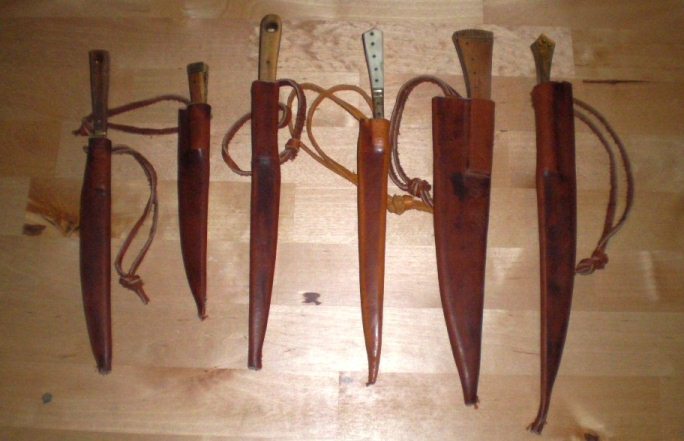
 Attachment: 76.69 KB Attachment: 76.69 KB

|
|
  |
 |
Josh Wilson

|
 Posted: Sun 16 Dec, 2012 1:56 pm Post subject: Posted: Sun 16 Dec, 2012 1:56 pm Post subject: |
 |
|
|
Very nice! Did you forge the blades yourself?
|
|
  |
 |
|
Radovan Geist
|
 Posted: Sun 16 Dec, 2012 10:22 pm Post subject: Posted: Sun 16 Dec, 2012 10:22 pm Post subject: |
 |
|
strictly speaking, they were not forged:) They were grinded and then quenched and tempered. But one day I will finally build my forge, and then... 
|
|
  |
 |
|
Perry L. Goss
|
 Posted: Mon 17 Dec, 2012 5:40 am Post subject: "not perfect" blades... Posted: Mon 17 Dec, 2012 5:40 am Post subject: "not perfect" blades... |
 |
|
Radovan:
Nice work. There is something about the..."not perfect" gear. It has its own appeal. Not everyone could have a full plate armour, not everyone could have a silver hilted Samuel Bell bowie.
I like them!
|
|
  |
 |
|
Radovan Geist
|
 Posted: Mon 17 Dec, 2012 6:20 am Post subject: Posted: Mon 17 Dec, 2012 6:20 am Post subject: |
 |
|
thank you for encouraging words! In fact, there is a certain level that you can achieve with angle grinder, then one would need more sophisticated tools:) At the same time, "uebung macht den meister", so I just keep on tryin´ 
|
|
  |
 |
Leo Todeschini
Industry Professional

|
|
   |
 |
|
Radovan Geist
|
 Posted: Wed 19 Dec, 2012 12:51 pm Post subject: Posted: Wed 19 Dec, 2012 12:51 pm Post subject: |
 |
|
...and here is another one, just finished. It is my first "serious" attempt for a tang construction. Handle is a combination of brass, bone and rose-wood.
Doing this project, I have stumbled onto one problem: how to cold-peen the tang, without damaging the blade? The best I came up with was wrapping the blade in a sheet of paper and clawing it really hard in a vice. Is there possibly a better method? Any advice appreciated... thanks.
 Attachment: 68.99 KB Attachment: 68.99 KB
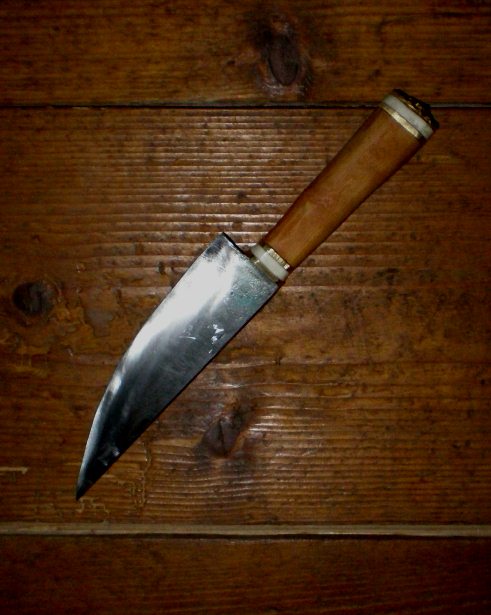
 Attachment: 56.36 KB Attachment: 56.36 KB
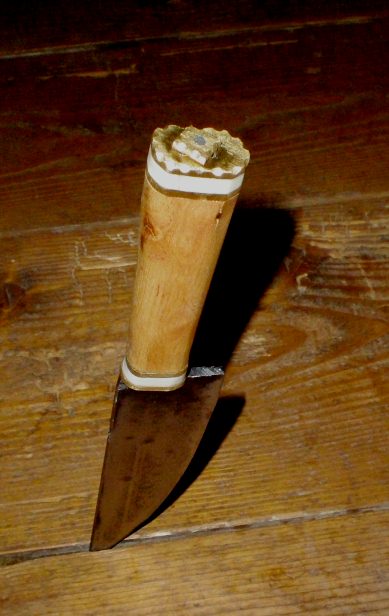
|
|
  |
 |
|
Dustin R. Reagan
|
 Posted: Wed 19 Dec, 2012 2:32 pm Post subject: Posted: Wed 19 Dec, 2012 2:32 pm Post subject: |
 |
|
| Radovan Geist wrote: |
Doing this project, I have stumbled onto one problem: how to cold-peen the tang, without damaging the blade? The best I came up with was wrapping the blade in a sheet of paper and clawing it really hard in a vice. Is there possibly a better method? Any advice appreciated... thanks. |
Nice knives! They look like they came straight out of the river Thames! =]
Really, i think you nailed the handle construction dead-on on a lot of those knives (I especially like the really skinny, delicate handles).
A couple options for holding the blade in a vice without damage:
-Leather-faced jaws.
-Brass, Aluminum or Lead inserts for your vice jaws (basically any soft metal).
|
|
  |
 |
|
Radovan Geist
|
 Posted: Thu 20 Dec, 2012 3:28 am Post subject: Posted: Thu 20 Dec, 2012 3:28 am Post subject: |
 |
|
|
thank you! i have a piece of thick leather from an old belt, somewhere in my workshop, that should work well. thanks again!
|
|
  |
 |
|
Radovan Geist
|
 Posted: Sun 17 Mar, 2013 11:57 pm Post subject: Posted: Sun 17 Mar, 2013 11:57 pm Post subject: |
 |
|
Dear all, let me contribute with my latest creations. The first one is a large cooking knife. It still needs some polishing on its blade, and I will probably re-shape the handle - so please take it as a work in progress:)
The second one was for my fiend´s birthday. I wanted to make it more special (and try a new technique), so it has a brass inlay work on its blade. It´s not perfect, but I´m rather happy with the result.
 Attachment: 86.35 KB Attachment: 86.35 KB
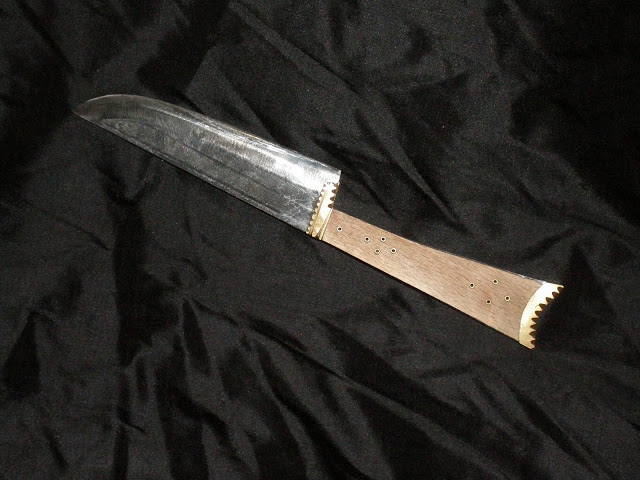
 Attachment: 57.06 KB Attachment: 57.06 KB
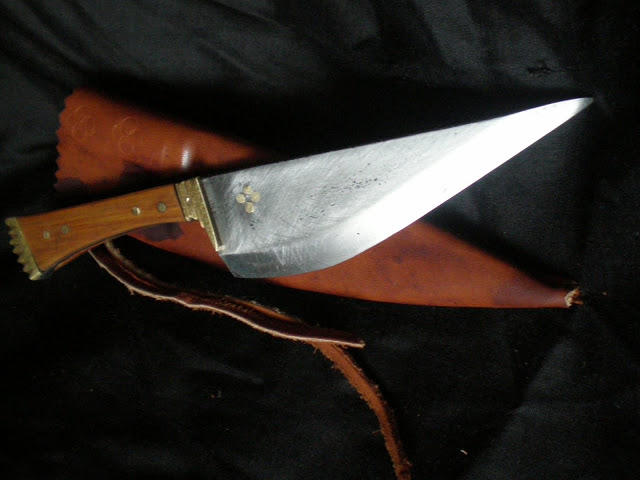
|
|
  |
 |
|
Radovan Geist
|
 Posted: Sun 05 May, 2013 10:59 pm Post subject: Posted: Sun 05 May, 2013 10:59 pm Post subject: |
 |
|
After a while I managed to finish two more knives. The first one is a slender eating knife, inspired by some 15th cent German examples, with full-brass scales. The method was rather un-sophisticated (scales are riveted, not soldered), but I more or less like the result.
The second one is a larger eating knife, with brass and horn scales and some brass decoration. Here I´d like to ask for your advice: how would you polish horn to a high gloss? I was working with a sand paper, but achieved only this "satin look". Thanks in advance...
 Attachment: 97.58 KB Attachment: 97.58 KB

 Attachment: 126.47 KB Attachment: 126.47 KB
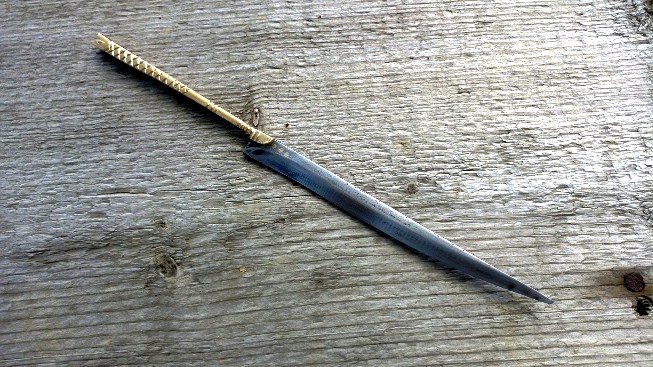
 Attachment: 73.56 KB Attachment: 73.56 KB
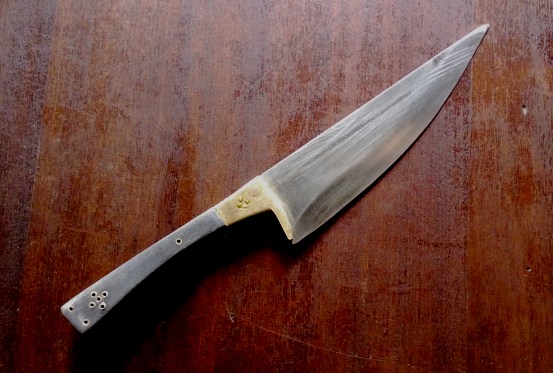
 Attachment: 92.97 KB Attachment: 92.97 KB
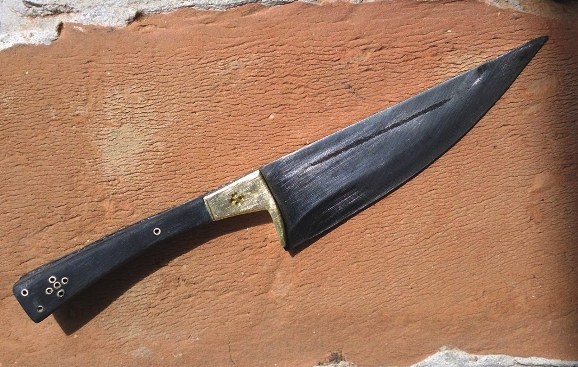
 Attachment: 96.79 KB Attachment: 96.79 KB
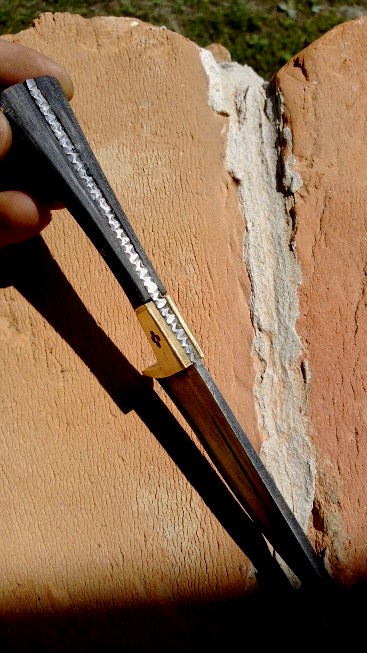
|
|
  |
 |
|
Tjarand Matre
Location: Nøtterøy, Norway Joined: 19 Sep 2010
Posts: 159
|
 Posted: Mon 06 May, 2013 2:29 am Post subject: Posted: Mon 06 May, 2013 2:29 am Post subject: |
 |
|
|
Really nice details!
|
|
   |
 |
|
Justin King
Industry Professional
|
 Posted: Mon 06 May, 2013 6:56 am Post subject: Posted: Mon 06 May, 2013 6:56 am Post subject: |
 |
|
|
Horn finishes well with sandpaper and steel wool, I usually sand to about 600p and then polish with 000 steel wool. Very nice work by the way!
|
|
  |
 |
|
Radovan Geist
|
 Posted: Mon 06 May, 2013 10:06 pm Post subject: Posted: Mon 06 May, 2013 10:06 pm Post subject: |
 |
|
|
thank you. i did use sandpaper, but I shall try steel wool.
|
|
  |
 |
Bjorn Hagstrom

|
 Posted: Tue 07 May, 2013 1:02 am Post subject: Posted: Tue 07 May, 2013 1:02 am Post subject: |
 |
|
Lovely, lovely knives. One can't possibly have too many knives..
There is nothing quite as sad as a one man conga-line...
|
|
   |
 |
|
Radovan Geist
|
 Posted: Thu 06 Jun, 2013 8:04 am Post subject: Posted: Thu 06 Jun, 2013 8:04 am Post subject: |
 |
|
...and here´s another one. this time a larger cooking knife.Shape was inspired by some 15th cent. artwork.
The blade was made from a scrap piece of rusted metal, which was probably a broken blade from grass-cutter. I found it laying in the corner of our garden. I have cleaned it chemically and mechanically, but it still retains a "rustic look" (I know that it´s often just a code-word for "not very well-kept"  ) )
The scales are from brass and elm, riveted by solid brass rivets. The knife still needs a sheath, but it will have to wait for a smaller brother, to make a nice cooking-set. All comments and criticism are welcome.
 Attachment: 81.58 KB Attachment: 81.58 KB
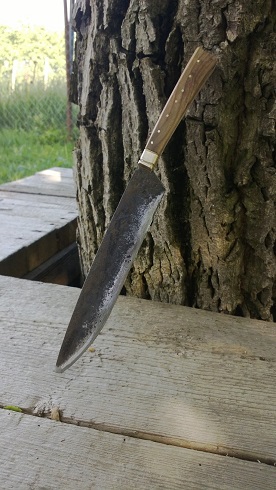
|
|
  |
 |
|
Radovan Geist
|
 Posted: Tue 12 Nov, 2013 10:51 pm Post subject: Posted: Tue 12 Nov, 2013 10:51 pm Post subject: |
 |
|
I´ve finished another one. This one will be part of a separate project of "upgrade" on one of my Langes Messer (a new handle, scabbard and a by-knife with pricker), but given the number of projects waiting on my work-bench, I don´t think it could materialise very fast:)
However, until then I have a rather large knife (27 cm), with a bolster and a butt from mild steel and a pear-wood handle treated with oil. Pins are from mild steel.
 Attachment: 102.24 KB Attachment: 102.24 KB
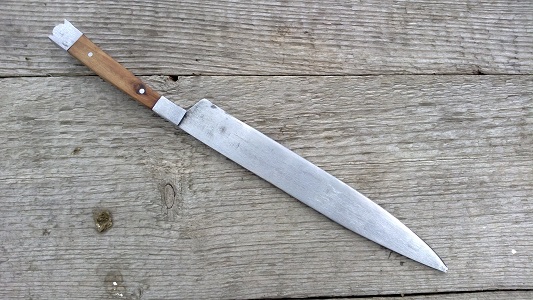
 Attachment: 79.7 KB Attachment: 79.7 KB
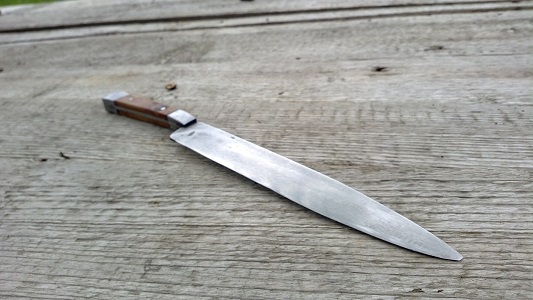
|
|
  |
 |
Kai Lawson

|
 Posted: Wed 13 Nov, 2013 4:06 pm Post subject: Posted: Wed 13 Nov, 2013 4:06 pm Post subject: |
 |
|
That 'friend's birthday knife' and the knives immediately following it have really neat shapes--were they historically inspired?
"And they crossed swords."
--William Goldman, alias S. Morgenstern
|
|
  |
 |
|
Radovan Geist
|
 Posted: Wed 13 Nov, 2013 10:42 pm Post subject: Posted: Wed 13 Nov, 2013 10:42 pm Post subject: |
 |
|
Thanks Kai, yes they were inspired by different pieces found in artwork. My main source was this database: http://tethys.imareal.sbg.ac.at/realonline/
Some of the blades were also inspired by originals - here my main source is Herman Historica auctions.
|
|
  |
 |
Julien M

|
 Posted: Sun 19 Jan, 2014 2:51 am Post subject: Posted: Sun 19 Jan, 2014 2:51 am Post subject: |
 |
|
Was browsing around for your past work Radovan and I think it's really excellent. You have an eye for eating knife design for sure.
It's funny because I recall you said on another of your topic that your work was amateurish (found it: "I have to stress that it´s just very amateurish, learning by doing exercise"). Well you, lean fast! so I really don't agree as the above knives tell me otherwise. Your Bauerwehr makes the point even more. They also tell me you are comfortable with most of the techniques needed to achieve a pro level project (pinning, riveting, cutting and shaping a blade, heat treatment).
The one thing that is a bit of a let down is your finish (blade and sometimes the sides of your wooden handle are a bit rought), which is really awkward as it is the easiest part really. It looks like you are in a hurry to finish  Granted finishing is often very boring but well worth the effort. You work mostly with an angle grinder, and it leaves grinding marks. Granted finishing is often very boring but well worth the effort. You work mostly with an angle grinder, and it leaves grinding marks.
Short answer: you need a belt grinder. I have no room for a backstand at present, but I am finishing blades and hilt components with a small 20£ aldi hand held belt sander, that has attachments to clamp it on a workbench belt facing up. I thought little of it when I bought it when grocery shopping, but I would be unable to complete most of my projects without it. I just bought quality belts on ebay, grit 40 would deal with those grind marks with little efforts. It has variable speed. Now this piece of equipment would make any professional blade smith have a good laugh, but what the hell - it does the job. I've done scabbard cores with it, shaped mild steel guards (angle grinder+this to refine and finish).
Sandpaper also does the trick, but will take more efforts. I use sanding sponge preferably, they speed up the work.
Otherwise clamp you blade on a long wooden slats that will extend beyond your workshop. Use double side adhesive to secure your sandpaper to a piece of hard wood that you will hold with both hands pressing on your blade. Then back and forth with a little oil...boooring yes. but this will work 
Hope the above will help. In any case I'll follow your projects with great interest.
Cheers,
J
|
|
  |
 |
|
|

